Die griechische Kleidung - von der Sandale bis zur Kopfbedeckung
WOMEN
Chiton Peplos archaic name and version of Doric chiton.
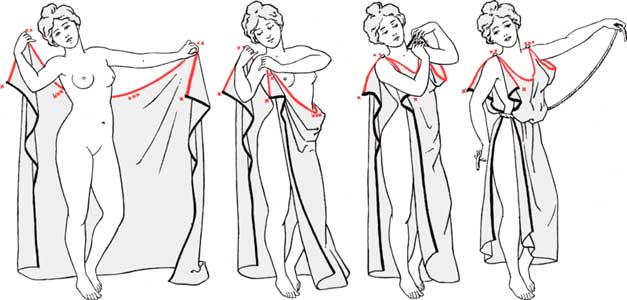
Doric: ( chiton with deep overfold at top, fastened with fibula at shoulder wool). The rectangle of fabric measured approximately one foot longer than the wearer's height and was twice as long as the measurement from fingertip to fingertip. The top edge is folded down to form the Apotygma and then the rectangle is folded in half around the wearer's body with the fold on the left. It was pinned at the shoulders with fibulae and then a belt was worn at the waist to control the fullness.
Apoptygma The portion of the fabric folded over the top of the Doric Chiton.
Kolpos portion of fabric in a Doric Chiton which is bloused when drawn up and allowed to hang over and below the belt, forming a pocket or baggy fold.
Ionic Chiton mostly replaced with time the Doric Chiton and was longer, fuller fastened with many small brooches at shoulder (linen, silk ) A rectangular piece of fabric which was usually linen and sometimes silk. The Ionic Chiton was based on the distance from shoulder to ankle of the wearer and could be as much as 3 yards wide. The top of the garment was held together with fibulae and the fabric could be draped to create the appearance of sleeves.
Chitoniskos
Himation “mantle” (usually over the chiton)
Some Comments from Gossman/Lewis (Greek Fashion Terms)

Woman fashion for various aspects of life; practical for hunting, elegant for a visit in the temple and “sexy” (we women who dwell in the retirement of the household, clad in diaphanous garments of yellow silk ..Aristophanes Lysistrata).
Allika ( Ἄλλικα). A short mantle among the Thessalians: "a mantle fastened with gilt brooches The local people call this gallix (or wallix)
Epiblema: A small cloak like a himation worn over other garments. In the Archaic period fastened at one shoulder later sometimes at both shoulders.
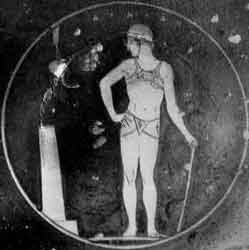
Euaion painter, Atalante wearing a "bikini", Louvre CA2259
Special words
Amphimashalos ( Ἀμφιμάσχαλος) Double-armholed sleeved himation. But some say that it is a servile garment, or a short tunic. The himation of the workmen was single-armholed, where they used to sew up the one armhole. Aristophanes [Knights]: "you never thought him worthy of a double-armholer."
Anaxyrides or Thylakoi (ἀναξυρίδες, θύλακοι) Trousers , usually used only by non-Greeks, exception some Greek colonists in the black sea region in the Roman period.
Doriazein (Δωριάζειν): To be half-naked: for it is a Dorian custom [for girls] to reveal the body at the side, because they do not have girdles, but for the most part they wear chitons. In Sparta even the maidens appear completely naked. (Δωριάζειν: παραγυμνοῦσθαι: Δωρικὸν γάρ ἐστι τὸ παραφαίνειν τὸ σῶμα, διὰ τὸ μηδὲ ζώνας ἔχειν, τὸ πολὺ δὲ χιτῶνας φορεῖν: ἐν δὲ Σπάρτῃ καὶ τὰς κόρας γυμνὰς φαίνεσθαι. )
Kimberine (Κιμβέρινον) A kind of himation, named after a place. "I will put on a Kimberine (κιμβέρινον ἐνδύσομαι)” Aristophanes Lysistrata.
Periskelis "anklet "
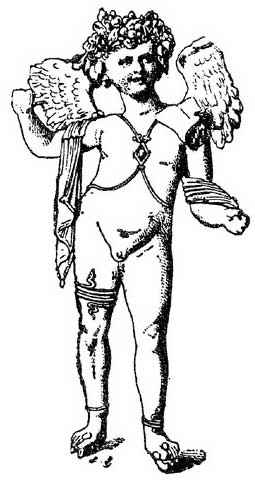
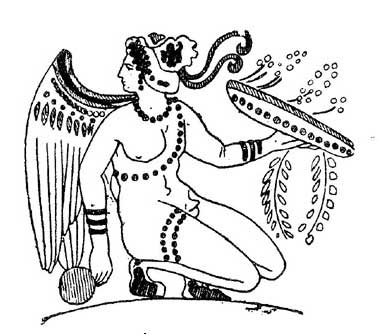
Two figures wearing a Periskelis (there are different types)
Coae vestes, semitransparent light silk dresses , a great success of the fashion industry on the island of Kos used by the Romans, and mentioned by various authors such as Lucian of Samosata
Also famous are the transparent clothes from Amorgos were women according to Aristophanes in Lysistrata appear almost nude.
Silk in Greece , Gisela M. A. Richter American Journal of Archaeology, Vol. 33, No. 1 (Jan. - Mar., 1929), pp. 27-33
SUDA Online
From a Gutenberg Text File A Day in Old Athens, William Stearns Davis, Professor of Ancient History in the University of Minnesota:
Chapter VI. Athenian Costume.
33. The General Nature of Greek Dress.--In every age the important kingdom of dress has been reserved for the peculiar sovereignty of woman. This is true in Athens, though not perhaps to the extent of later ages. Still an Athenian lady will take an interest in "purple and fine linen" far exceeding that of her husband, and where is there a more fitting place than this in which to answer for an Athenian, the ever important question "wherewithal shall I be clothed"? Once again the Athenian climate comes in as a factor, this time in the problem of wardrobe. Two general styles of garment have divided the allegiance of the world,--the clothes that are PUT ON and the clothes that are WRAPPED AROUND. The former style, with its jackets, trousers, and leggings, is not absolutely unknown to the Athenians,--their old enemies, the Persians, wear these[*]; but such clumsy, inelegant garments are despised and ridiculed as fit only for the "Barbarians" who use them. They are not merely absurdly homely; they cannot even be thrown off promptly in an emergency, leaving the glorious human form free to put forth any noble effort. The Athenians wear the wrapped style of garments, which are, in final analysis, one or two large square pieces of cloth flung skillfully around the body and secured by a few well-placed pins. This costume is infinitely adjustable; it can be expanded into flowing draperies or contracted into an easy working dress by a few artful twitches. It can be nicely adjusted to meet the inevitable sense of "beauty" bred in the bone of every Athenian. True, on the cold days of midwinter the wearers will go about shivering; but cold days are the exception, warm days the rule, in genial Attica.[+]
[*]The Persians no doubt learned to use this style of garment during their life on the cold, windy steppes of Upper Asia, before they won their empire in the more genial south.
[+]The whole civilization of Athens was, of course, based on a climate in which artificial heat would be very little needed. A pot of glowing charcoal might be used to remove the chill of a room in the very coldest weather. Probably an Athenian would have regarded a climate in which furnace heat was demanded nearly eight months in the year as wholly unfit for civilized man.
This simplicity of costume has produced certain important results. There are practically no tailors in Athens, only cloth merchants, bleachers, and dyers. Again fashions (at least in the cut of the garments) seldom change. A cloak that was made in the days of Alcibiades (say 420 B.C.) can be worn with perfect propriety to-day (360 B.C.) if merely it has escaped without severe use or moth holes. It may be more usual this year to wear one's garments a little higher or a little more trailing than formerly; but THAT is simply a matter for a shifting of the pins or of the girdle.
As a result, the Athenian seldom troubles about his "spring" or "winter" suit. His simple woolen garments wear a very long time; and they have often been slowly and laboriously spun and woven by his wife and her slave girls. Of course even a poor man will try to have a few changes of raiment,--something solid and coarse for every day, something of finer wool and gayer color for public and private festivals. The rich man will have a far larger wardrobe, and will pride himself on not being frequently seen in the same dress; yet even his outfit will seem very meager to the dandies of a later age.
34. the Masculine Chiton (χιτών ), Himation ( ἱμάτιον ), and Chlamya (χλαμύς ).--The essential garments of an Athenian man are only two--the CHITON and the HIMATION. The chiton may be briefly described as an oblong of woolen cloth large enough to wrap around the body somewhat closely, from the neck down to just above the knees. The side left open is fastened by fibule--elegantly wrought pins perhaps of silver or gold; in the closed side there is a slit for the arm. There is a girdle, and, if one wishes, the skirt of the chiton may be pulled up through it, and allowed to hang down in front, giving the effect of a blouse. The man of prompt action, the soldier, traveler, worker, is "well girded,"--his chiton is drawn high, but the deliberate old gentleman who parades the Agora, discussing poetry or statecraft, has his chiton falling almost to a trailing length. Only occasionally short sleeves were added to this very simple garment; they are considered effeminate, and are not esteemed. If one's arms get cold, one can protect them by pulling up the skirt, and wrapping the arms in the blouse thus created.
An Athenian gentleman when he is in the house wears nothing but his chiton; it is even proper for him to be seen wearing nothing else upon the streets, but then more usually he will add an outer cloak,--his HIMATION.
The himation is even simpler than the chiton. It is merely a generous oblong woolen shawl. There are innumerable ways of arranging it according to the impulse of the moment; but usually it has to be worn without pins, and that involves wrapping it rather tightly around the body, and keeping one of the hands confined to hold the cloak in place. That is no drawback, however, to a genteel wearer. It proclaims to the world that HE does not have to work, wearing his hands for a living; therefore he can keep them politely idle.[*]
The adjustment of the himation is a work of great art. A rich man will often have a special slave whose business it is to arrange the hang and the folds before his master moves forth in public; and woe to the careless fellow if the effect fails to display due elegance and dignity!
[*]Workingmen often wore no himation, and had a kind of chiton (an exomis) which was especially arranged to leave them with free use of their arms.
There is a third garment sometimes worn by Athenians. Young men who wish to appear very active, and genuine travelers, also wear a CHLAMYS, a kind of circular mantle or cape which swings jauntily over their shoulders, and will give good protection in foul weather.
There are almost no other masculine garments. No shirts (unless the chiton be one), no underwear. In their costume, as in so many things else, the Athenians exemplify their oft-praised virtue of simplicity.
35. The Dress of the Women.--The dress of the women is like that of the men, but differs, of course, in complexity. They also have a chiton,[*] which is more elaborately made, especially in the arrangement of the blouse; and probably there is involved a certain amount of real SEWING[+]; not merely of PINNING.
[*]This robe was sometimes known by the Homeric name of PEPLOS (πέπλος ).
[+]Probably with almost all Greek garments the main use of the needle was in the embroidery merely, or in the darning of holes and rents. It was by no means an essential in the real manufacture.
Greater care is needed in the adjustment of the "zone" (girdle), and half sleeves are the rule with women, while full sleeves are not unknown. A Greek lady again cannot imitate her husband, and appear in public in her chiton only. A himation, deftly adjusted, is absolutely indispensable whenever she shows herself outside the house.
These feminine garments are all, as a rule, more elaborately embroidered, more adorned with fringes and tassels, than those of the men. In arranging her dress the Athenian lady is not bound by the rigid precepts of fashion. Every separate toilette is an opportunity for a thousand little niceties and coquetries which she understands exceedingly well. If there is the least excuse for an expedition outside the house, her ladyship's bevy of serving maids will have a serious time of it. While their mistress cools herself with a huge peacock-feather fan, one maid is busy over her hair; a second holds the round metallic mirror before her; a third stands ready to extend the jewel box whence she can select finger rings, earrings, gold armlets, chains for her neck and hair, as well as the indispensable brooches whereon the stability of the whole costume depends. When she rises to have her himation draped around her, the directions she gives reveal her whole bent and character. A dignified and modest matron will have it folded loosely around her entire person, covering both arms and hands, and even drawing it over her head, leaving eyes and nose barely visible. Younger ladies will draw it close around the body so as to show the fine lines of their waists and shoulders. And in the summer heat the himation (for the less prudish) will become a light shawl floating loose and free over the shoulders, or only a kind of veil drawn so as to now conceal, now reveal, the face.
Children wear miniature imitations of the dress of their elders. Boys are taught to toughen their bodies by refraining from thick garments in cold weather. In hot weather they can frequently be seen playing about with very little clothing at all!
36. Footwear and Head Coverings.--Upon his feet the Athenian frequently wears nothing. He goes about his home barefoot; and not seldom he enjoys the delight of running across the open greensward with his unsandaled feet pressing the springing ground; but normally when he walks abroad, he will wear SANDALS, a simple solid pair of open soles tied to his feet by leather thongs passing between the toes. For hard country walking and for hunting there is something like a high leather boot,[*] though doubtless these are counted uncomfortable for ordinary wear. As for the sandals, simple as they are, the Attic touch of elegance is often upon them. Upon the thongs of the sandals there is usually worked a choice pattern, in some brilliant color or even gilt.
[*]Actors, too, wore a leather boot with high soles to give them extra height--the COTHURNUS.
The Athenians need head coverings even less than footwear. Most of them have thick hair; baldness is an uncommon affliction; everybody is trained to walk under the full glare of Helios with little discomfort. Of course certain trades require hats, e.g. Sailors who can be almost identified by their rimless felt caps. Genteel travelers will wear wide-brimmed hats; but the ladies, as a rule, have no headgear besides their tastefully arranged hair, although they will partly atone for the lack, by having a maid walk just behind them with a gorgeously variegated parasol.
37. The Beauty of the Greek Dress.--Greek Costume, then, is something fully sharing in the national characteristics of harmony, simplicity, individuality. It is easy to see how admirably this style of dress is adapted to furnish over ready models and inspiration for the sculptor.[*] Unconventional in its arrangement, it is also unconventional in its color. A masculine crowd is not one unmitigated swarm of black and dark grays or browns, as with the multitude of a later age. On the contrary, white is counted as theoretically the most becoming color on any common occasion for either sex;[+] and on festival days even grave and elderly men will appear with chitons worked with brilliant embroidery along the borders, and with splendid himatia of some single clear hue—violet, red, purple, blue, or yellow. As for the costume of the groom at a wedding, it is far indeed from the "conventional black" of more degenerate days. He may well wear a purple-edged white chiton of fine Milesian wool, a brilliant scarlet himation, sandals with blue thongs and clasps of gold, and a chaplet of myrtle and violets.
His intended bride is led out to him in even more dazzling array. Her white sandal-thongs are embroidered with emeralds, rubies, and pearls. Around her neck is a necklace of gold richly set,--and she has magnificent golden armlets and pearl eardrops. Her hair is fragrant with Oriental nard, and is bound by a purple fillet and a chaplet of roses. Her ungloved fingers shine with jewels and rings. Her main costume is of a delicate saffron, and over it all, like a cloud, floats the silvery tissue of the nuptial veil.
[*]"The chiton became the mirror of the body," said the late writer Achilles Tatius.
[+]No doubt farmers and artisans either wore garments of a non-committal brown, or, more probably, let their originally white costume get utterly dirty.
38. Greek Toilet Frivolities.--From the standpoint of inherent fitness and beauty, this Athenian costume is the noblest ever seen by the world. Naturally there are ill-advised creatures who do not share the good taste of their fellows, or who try to deceive the world and themselves as to the ravages of that arch-enemy of the Hellene,--Old Age. Athenian women especially (though the men are not without their follies) are sometimes fond of rouge, false hair, and the like. Auburn hair is especially admired, and many fine dames bleach their tresses in a caustic wash to obtain it. The styles of feminine hair dressing seem to change from decade to decade much more than the arrangements of the garments. Now it is plaited and crimped hair that is in vogue, now the more beautiful "Psyche-knots"; yet even in their worst moods the Athenian women exhibit a sweet reasonableness. They have not yet fallen into the clutches of the Parisian hairdresser. The poets, of course, ridicule the foibles of the fair sex.[*]
Says one:--
The golden hair Nikylla wears
Is hers, who would have thought it?
She swears 'tis hers, and true she swears
For I know where she bought it!
And again:--
You give your cheeks a rosy stain,
With washes dye your hair;
But paint and washes both are vain
To give a youthful air.
An art so fruitless then forsake,
Which, though you much excel in,
You never can contrive to make
Old Hecuba young Helen.
[*]Translated in Falke's "Greece and Rome" (English translation, p. 69). These quotations probably date from a time considerably later than the hypothetical period of this sketch; but they are perfectly proper to apply to conditions in 360 B.C.
But enough of such scandals! All the best opinion--masculine and feminine--frowns on these follies. Let us think of the simple, dignified, and esthetically noble costume of the Athenians as not the least of their examples to another age.
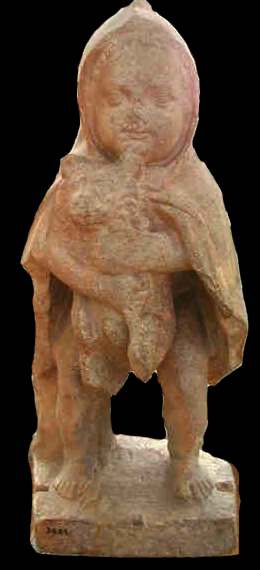
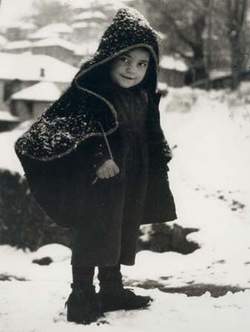
A younger child with a cat or dog?, National Museum of Athens. Compare with this image of a Greek boy taken 2300 years later by the photographer Dimitris Tloupas (1920 – 2003). The image is from this webpage “The Little Refugee” was found in 1922 in Gerontiko in Nissas (Asia Minor) by the archaeologist Konstantinos Kourouniotis and was brought to the National Museum in Athens in the first days of the destruction of Smyrna, August 1922. It dates from first century BC but was probably a copy from an earlier work from third century BC.
THE END William Smith, A Dictionary of Greek and Roman Antiquities, John Murray, London, 1875. p 220.
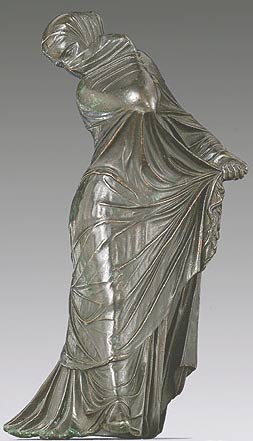
From the Metropolitan Museum of Art
Statuette of a veiled and masked dancer, 3rd–2nd century B.C.; Hellenistic Greek Bequest of Walter C. Baker, 1971 (1972.118.95)
The dancer wears a chiton and a himation, which are described in rich contrasts of texture, weight and mass. The long chiton reaches the floor, where it falls in regular, deep and tubular folds, which spread out like a peacock’s tail, trailing behind the dancer and balancing the tilted head and the extended forward left arm. The mantle is smooth, shiny, light and transparent. Its diaphanous quality is carefully depicted: the overfold of the chiton, as well as the cord around the waist, show through at the hip. Thus a contrast is created between the horizontal, protruding and diverging folds of the himation and the vertical, deep and parallel folds of the chiton worn underneath. The back view shows long fringes, which seem to flutter behind the dancer as a result of her swift turning, Elisabet Friesländer , The Mantle Dancer in the Hellenistic Period: Glorification of the Himation.
.Alcmaeon Son of Megacles:
On his arrival at Sardis, Croesus made him a present of as much gold as he could carry out of the treasury. Alcmaeon took the king at his word, by putting on a most capacious dress, the folds of which (as well as the vacant space of a pair of very wide boots, also provided for the occasion) he stuffed with gold, and then filled his mouth and hair with gold dust. Croesus laughed at the trick.
Materials
Cotton , Linen, Flax , Silk , Dyes
See also:
BOOKS
Goddess: The Classical Mode; By Harold Koda exhibition catalogue for the Metropolitan Museum of Art costume institute. It shows the influence of ancient Greek and Roman fashion in more modern times on women's costume
William Smith, A Dictionary of Greek and Roman Antiquities, John Murray, London, 1875
| Ancient Greece
Science, Technology , Medicine , Warfare, , Biographies , Life , Cities/Places/Maps , Arts , Literature , Philosophy ,Olympics, Mythology , History , Images Medieval Greece / Byzantine Empire Science, Technology, Arts, , Warfare , Literature, Biographies, Icons, History Modern Greece Cities, Islands, Regions, Fauna/Flora ,Biographies , History , Warfare, Science/Technology, Literature, Music , Arts , Film/Actors , Sport , Fashion --- |

